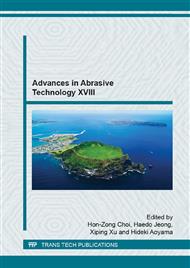p.60
p.66
p.71
p.78
p.84
p.90
p.97
p.104
p.113
Experimental Study of Fabrication of Cast-Iron Bonded cBN Grinding Wheels by V-EPC (I) - The Influence Factors on the Qualities of Grinding Layer
Abstract:
The new processing technique of vacuum evaporative pattern casting (V-EPC) process was explored to fabricate the cast-iron bonded cBN grinding wheels in this paper. The influences of pouring temperature, degree of vacuum, percentage and size of the cBN grits on the microstructures, distribution and thermal damage of cBN grits in the grinding layer, as well as the surface quality of the grinding layer were investigated. The experimental results revealed that thermal damage of the cBN grits and severe damage of nodulizer occurred when the pouring temperature was around 1480°C. The optimized pouring temperature for fabricate the austenite-bainite ductile cast-iron bonded cBN grinding wheels was about 1400°C. The appropriate degree of vacuum was 0.06Mpa. Too high or too low level of degree of vacuum would result in low surface quality of the grinding layer. The uniformity of the distribution of cBN grits in the metal matrix improved with the increase of the percentage and size of the cBN grits.
Info:
Periodical:
Pages:
84-89
Citation:
Online since:
January 2016
Authors:
Price:
Сopyright:
© 2016 Trans Tech Publications Ltd. All Rights Reserved
Share:
Citation:


